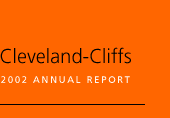
Safe Production is a Core Value at Cleveland-Cliffs Inc – Goals: record production with: lack of injuries....good housekeeping and orderly work areas....well-maintained equipment....proper training and procedures.... looking out for and correcting each other....safe conditions, safe behavior....Sentinel of Safety award winner.
Safety and Health Performance
For Cliffs, safety and production of iron ore are inseparable partners; we must have both for success. Cliffs' 2002 corporatewide safety performance was the best in its history. Cliffs' frequency rate for Mine Safety and Heath Administration (MSHA) reportable accidents was 3.9, and for lost-time accidents (LTA) the frequency rate was 1.9. In both cases, this is more than a 30 percent improvement from 2001. While this is a significant improvement, in 2003 Cliffs' safe production goal is to achieve a 50 percent reduction in MSHA accident frequency rates to a level of 2.0.
Cliffs' Northshore Mine has achieved a safe production record of over 800 days without an LTA, and Cliffs' Technology Center employees recently achieved 2.6 million work hours, or 25 years, without an LTA.
The Northshore Mine qualified as a candidate for the 2001 Sentinels of Safety, an award for the mine with the highest number of hours worked without an LTA during a calendar year. Of the five mines qualifying for the 2001 open pit division Sentinels of Safety Award, Northshore ranked second with regard to
the highest number of employee hours worked without an LTA. As of March 1, 2003, the Northshore Mine had worked 897 consecutive days without an LTA and is eligible for the 2002 Sentinels of Safety Award.
Cliffs has a strong presence in iron ore industry safety, as evidenced by MSHA reportable frequency rates. Currently eight iron ore mines operate in the Great Lakes area; Cliffs has ownership in four. In 2002, Cliffs' U.S. mining operations held four of the top six rankings.
Safety Accountability
Safety accountability relies on holding management accountable to perform key “upstream” accident prevention activities as part of their everyday responsibilities. Each manager is assigned key activities and held accountable to perform these activities. A comprehensive safety-training program will be implemented in early 2003. This is the culmination of a three-year project by the Safety Leadership Team to introduce and develop safe production at all levels of the Company. The training targets frontline coordinators and consists of five one-day workshops to be repeated over the next 12 to 18 months. Through these workshops, employees will develop skills that will aid them in
managing day-to-day safety responsibilities.
Safety System Audits
Cliffs' Safety System Audit, which has been conducted annually for 12 years, was revised in 2002. An internal safety systems audit was conducted at each operation, and an employee perception survey was also performed. The survey, completed by more than 1,000 employees, evaluated their perceptions of Cliffs' safety performance in 21 safety-related areas. Results were generally positive, but some areas were identified for improvement.
Internal safety system auditors have begun developing a new comprehensive audit that combines the world's latest safety and loss control best practices with Cliffs' Safe Production Core Value and current company safety policy and systems. The new audit also includes an evaluation of environmental management systems, and Safety Leadership has formed an alliance with Cliffs' environmental management to develop an integrated environmental, health and safety system audit. Baseline audits using the new protocol are planned for 2003 and 2004.
Industrial Hygiene
The Hazard Communications rule under MSHA was promulgated in June 2002, affecting all U.S. mining operations. Hazard communications programs were implemented at each site, followed up with training. An Internet-based, corporatewide material safety data sheet system was implemented, allowing employees immediate online access to product safety information, thus eliminating a less user-friendly paper system.
|



